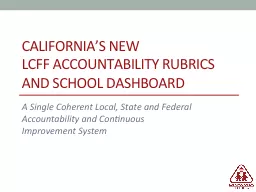

LCFF Accountability Rubrics and School DAshboard A Single Coherent Local State and Federal Accountability and Continuous Improvement System What Does That Mean LCFF Local Control Funding Formula the funding regulations that began in 2013 that moved more of the decision making to the ID: 611776
Download Presentation The PPT/PDF document "California’s New" is the property of its rightful owner. Permission is granted to download and print the materials on this web site for personal, non-commercial use only, and to display it on your personal computer provided you do not modify the materials and that you retain all copyright notices contained in the materials. By downloading content from our website, you accept the terms of this agreement.
Slide1
California’s New LCFF Accountability Rubrics and School DAshboard
A Single Coherent Local, State and Federal Accountability and Continuous Improvement SystemSlide2
What Does That Mean???
LCFF
– Local Control Funding Formula; the funding regulations that began in 2013 that moved more of the decision making to the district level.
Accountability – how well districts and schools are doing.Rubric – Describes specific criteria for grading or scoring
2Slide3
What Does That Mean???
Coherent
–The new LCFF Accountability Rubrics will be used to determine information about school and district progress under both the federal and state accountability systems.Before LCFF - California had two very different rating systems.
The state used Academic Performance Index (API) and the federal government used Adequate Yearly Progress (AYP). Many schools did well on the API measurement, but not as well for the AYP.Slide4
What Does That Mean???Continuous Improvement System – how the data from the rubrics can help each student be successful.
Slide5
What Does This Look Like?The accountability tool that will help a district see how their students are doing is
the
evaluation
rubric:They include indicators for all
8 LCFF State Priorities
Is
displayed on a public web interface
called
the California
School
Dashboard
Assists districts and charters
in identifying strengths
, and areas in need of improvementSlide6
LCFF Accountability RubricsSlide7Slide8Slide9
The Rubric
Indicators
(These
are like the subjects on a report card)
State Indicators:
Academic
- Grades 3-8 ELA and Math SBAC (and Science*)
English
Learner Composite
(LCAP Priority
4) - EL Proficiency and Reclassification
Graduation
Rate
(LCAP Priority
5)
Suspension
Rate
(LCAP Priority
6) - by grade span; LEA and School
College
and
Career* - (LCAP Priority 7 and 8)Grade 11 ELA and Math SBACCourse Completion - A-G, CTE, Academic, CTE Dual EnrollmentAP/IB Exam Pass Rates Chronic Absenteeism** when available
9Slide10
The Rubric
Indicators
(These
are like the subjects on a report card)
Local Performance Indicators
Appropriately
Assigned Teachers, Access to
Instructional
Materials, and Safe, Clean and Functional School Facilities (Priority 1
)
Implementation
of State Academic Standards (Priority 2)
Parent Engagement (Priority 3)
School Climate – Local Climate Surveys (Priority 6)
Each indicator will have state defined standards, evidence and criteria .
Districts
will assess their progress on these indicators as:
Met
/ Not Met / Not Met for Two or More
Years
10Slide11
The Rubrics and the LCAPSince the indicators on the LCFF Evaluation Rubrics are similar to the Expected Annual Measurable Outcome on the LCAP, districts are already working to improve those indicators through the actions in their LCAP.
Possible outcomes from LCAPs
The percent of students meeting or exceeding the standards on the SBAC in math will increase from 31% (in 2015-16) to 35% in 2016-17. (similar to the academic indicator)
The overall school suspension rate will decrease from 9% in 2015-16 to 8% for 2016-17 (suspension rate indicator)Slide12
Performance Levels
Based on both how a district/site is currently doing (status), and whether it is improving (change). Slide13
Next steps
Look at your district’s evaluation rubric. Where are the areas that need improvement?
Now look at the district’s LCAP, especially the annual update section. Has the district shown improvement in the outcomes related to the areas needing improvement?
What actions are in place to improve those outcomes? What other ideas do you have?Slide14
District information (to be completed by district)
District data is available at…
District areas of Focus
If you have questions please contact…